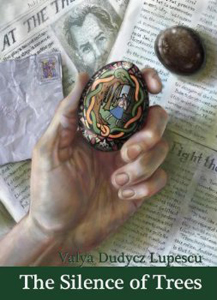The Silence of Trees
By Valya Dudycz Lupescu, 2010
Reviewed by Donna Quattrone
“I eagerly went onto the unknown, looking for magic, for mystery, for adventure. But sometimes magic finds you. Sometimes it comes in the least likely of forms: in a small black river rock, a deck of hand-painted cards, a sprig of purple herb, or an envelope from home’¦”
 Fairy tales are fantastical journeys; full of treacherous twists and turns, shadowed forests, unlikely helpers and often unlooked for opportunities. There is always magic of course, and usually love as well.
Fairy tales are fantastical journeys; full of treacherous twists and turns, shadowed forests, unlikely helpers and often unlooked for opportunities. There is always magic of course, and usually love as well.
The Silence of Trees is a tale that contains all of those things. Often billed as historical fiction, the story revolves around a Ukrainian woman named Nadya who, as a girl, sets out into the woods against her mother’s wishes to have her fortune told. The music that entices her to the gypsy camp is as mysterious as the destiny that is described for her there and, from that night forward, Nadya’s life is forever changed.
The brunt of The Silence of Trees is told from the perspective of the immigrant grandmother Nadya has become. She looks back upon her experiences and the choices she has made from the security of her family home in Chicago, a dwelling where cultural traditions still reign, myriad secrets abound and ghosts that are far from silent linger on.
Nadya’s anecdotes bring history to life and also serve to chronicle her attempts to come to terms with her past, a quest that is fundamentally necessary for both herself and her family. The move to integrate the old and the new into her current life is presented in a way that is utterly personal and universal all at once, cumulating in a tale that is poignantly engaging.
The Silence of Trees is Valya Dudycz Lupescu’s first novel, and it clearly exemplifies the author’s sheer joy in spinning tales. Her writing style is eloquent and wonderfully atmospheric; it weaves a web that draws the reader in, right from the beginning of the book. The prose echoes with honest emotion viewed through the lens of wisdom and then competently transposed in the voice of one who readily acknowledges the impact that stories can have upon our lives.
The narrative is richly informed by folklore and deeply imbued with fairy tales and the stuff they are made of. House spirits are appeased and old women are honored, even meals are rife with meaningful rituals. In The Silence of Trees, traditional tales are more than simple gifts handed down from from one generation to the other; they become the breadcrumbs that can lead one home. They are utilized not just to entertain, but also to illuminate the path to transformation and, perhaps most importantly, to remind us of the possibility of a happily ever after.
